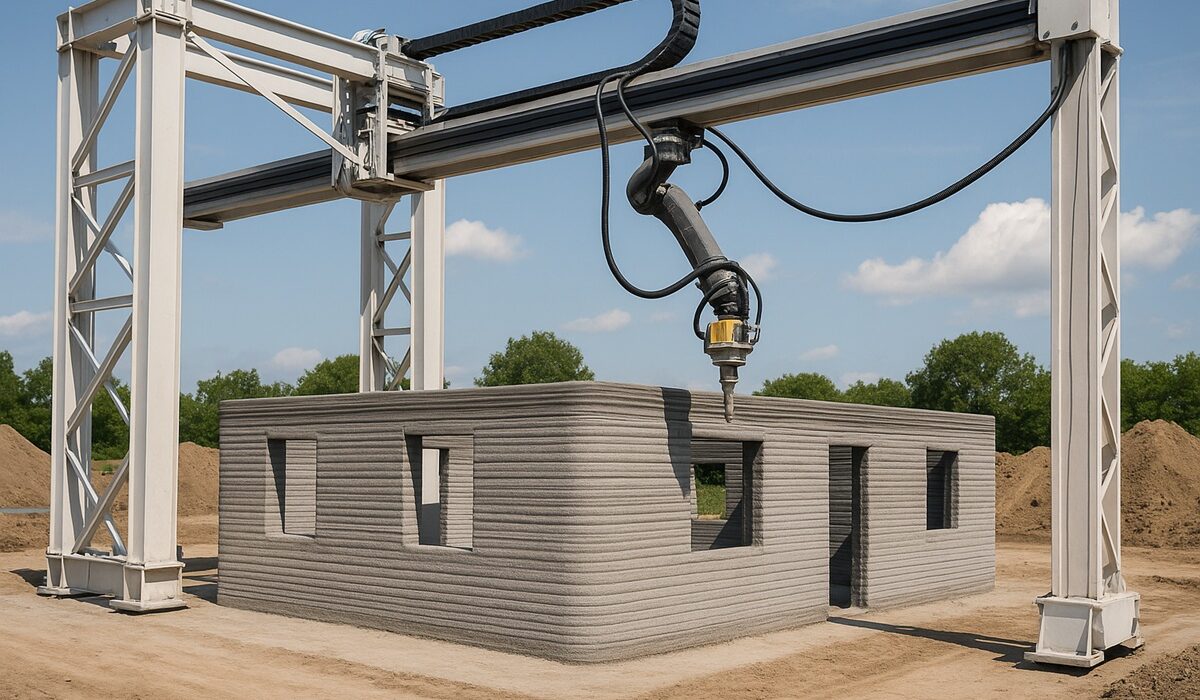3D printing in the construction industry have grown leaps and bounds over the last decade. It’s is an exciting, rapidly maturing technology that already solves real-world problems, but it still faces some technical, regulatory and commercial hurdles before it can be adopted for mainstream use. Let’s find out whether 3D printed construction is viable and what challenges it faces.
What is 3D printing in construction?
Concrete 3D printing, also called additive construction is the process of using large robotic printers to extrude layers of specially formulated cement to build walls and structural elements. The digital model drives the robot printing complex shapes, cavities or insulation layers with minimal formwork.
Advantages
Speed: Large sections of structural walls can be printed in hours or days rather than weeks of conventional construction work.
Less material waste: Printing only what you need reduces formwork and cut-offs, which helps lower construction waste.
Design freedom: 3D printing allows for curves, integrated conduits and non-standard geometry which showcasing additional design elements and potentially saving on building costs.
Potential labour safety and shortages relief: Automation reduces repetitive manual work, as well as risk on site. If there is a shortage of labour in the industry, this can further remove bottlenecks ensuring faster delivery of projects.
The real limits and challenges
Materials & structural certainty: Not all concrete mixes print well. Ensuring consistent strength, durability, and an appropriate bond between printed layers can be an engineering challenge.
Regulation & approvals: Building codes in many countries don’t yet have explicit clauses for 3D printed structural elements. Manufacturers and builders must demonstrate compliance case-by-case with existing codes. That process can be time-consuming and costly.
Cost & scale: Printer purchases can be expensive. Specialized materials and the need for trained operators mean early projects can be more expensive or only marginally cheaper than traditional methods. It is only when an operation is scaled that costs can start to decrease in the long run.
Integration of services & finishes: Printing a structural shell is one thing; integrating plumbing, electrical, windows, and insulation details in a cost-effective way is still being refined.
When does 3D printing make sense today?
All around the world 3D printing houses and buildings are being tested. Concrete 3D printing has moved from lab demos to real houses, apartments and small commercial buildings. Examples include single family homes printed in hours, multi unit projects in Europe and government backed affordable housing pilots. These projects show the technology is already viable for certain use cases.
Good fits today include:
Affordable or social housing pilots where speed and repeatability reduce per-unit costs.
Custom one-off homes or unique architectural elements where design freedom has high value.
Remote or labour-constrained sites where bringing a robot to site reduces need for large crews.
Less attractive today for 3D printing:
High-rise towers (still early), complex mixed-use shells requiring deep integration of services, or very small lots where mobilizing a printer isn’t economical.
What needs to happen for it to become mainstream?
Clearer codes and standards that explicitly incorporate additive construction methods, so approvals become routine rather than project-by-project.
Material and process standardization so structural performance and durability are well documented across climates (including hot, dry WA summers and coastal exposures).
Business models that scale: repeating a small number of proven house designs reduces engineers’ compliance costs and makes unit economics compelling.
Supply chain for specialized mixes and trained operators in regional markets like Perth so printers can be deployed without long lead times.
Conclusion
3D printing in construction sits between hype and future: it’s already real for specific uses (rapid wall printing, design-led builds, pilot affordable housing), and it has genuine long-term potential to change the construction industry. Yet, widespread adoption depends on materials, standards, and business models maturing. In Perth and across Australia, the technology is advancing fast enough that builders, certifiers, materials suppliers and policymakers should be paying attention now, not later.
